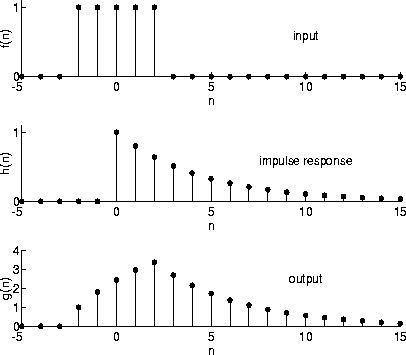Linear shift-invariant systems
Electrical networks or optical imaging systems transform their input (e.g. voltages or light intensities) as a function of time and/or of space. In general such one- or more-dimensional transformations S map some input functions f(x,y,z;t) into some output functions g(x,y,z;t):
The transformation is called a linear system L, if the following equation holds for all functions f1, f2 and any a and b:
i.e. an arbitrary function that can be expressed as a sum of several elementary excitations will be transformed by a linear system as the superposition of the output of these excitations. In general:
L is called shift-invariant if and only if a shift (translation) of the input causes the same shift of the output:
Electrical networks or optical systems are usually treated as time- and space-invariant, respectively.
To simplify the notation and to derive the computational aspects, we choose a one-dimensional discrete system. With
we can write the identity:
Application of the linear operator L produces:
which is the superposition sum of the shift-varying impulse response h(k;i). If L is shift-invariant, i.e. h(k-i) = L[d(k-i)], the equation can be written in form of a convolution
or abbreviated:
The impulse response h is called the point spread function in the two-dimensional case.
If F,G and H are the Fourier transforms of f,g and h, respectively,
with the frequency response or transfer function H of the linear shift-invariant system L. For more ![]() e.g. Kunt80 details and more references or Goodman68.
e.g. Kunt80 details and more references or Goodman68.


